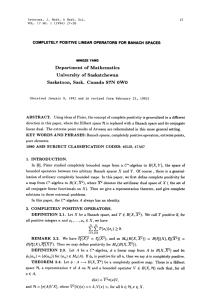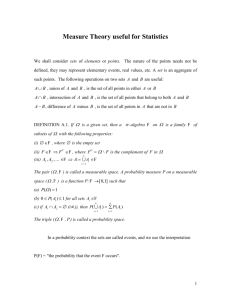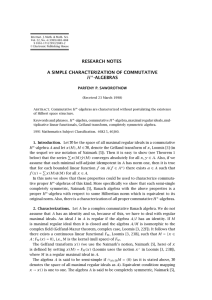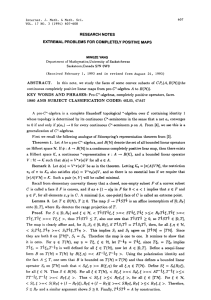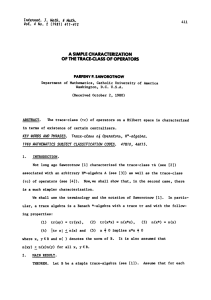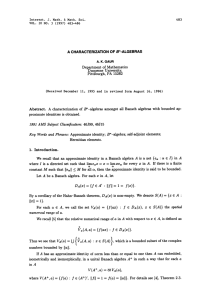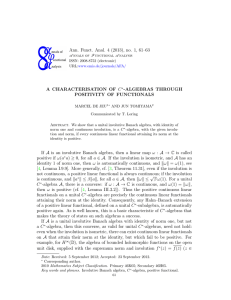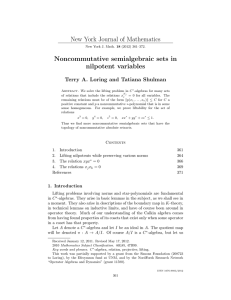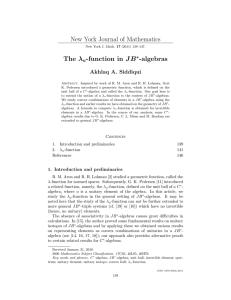CHARACTERIZATION OF AN -ALGEBRAS IN TERMS OF A TRACE PARFENY SAWOROTNOW
advertisement
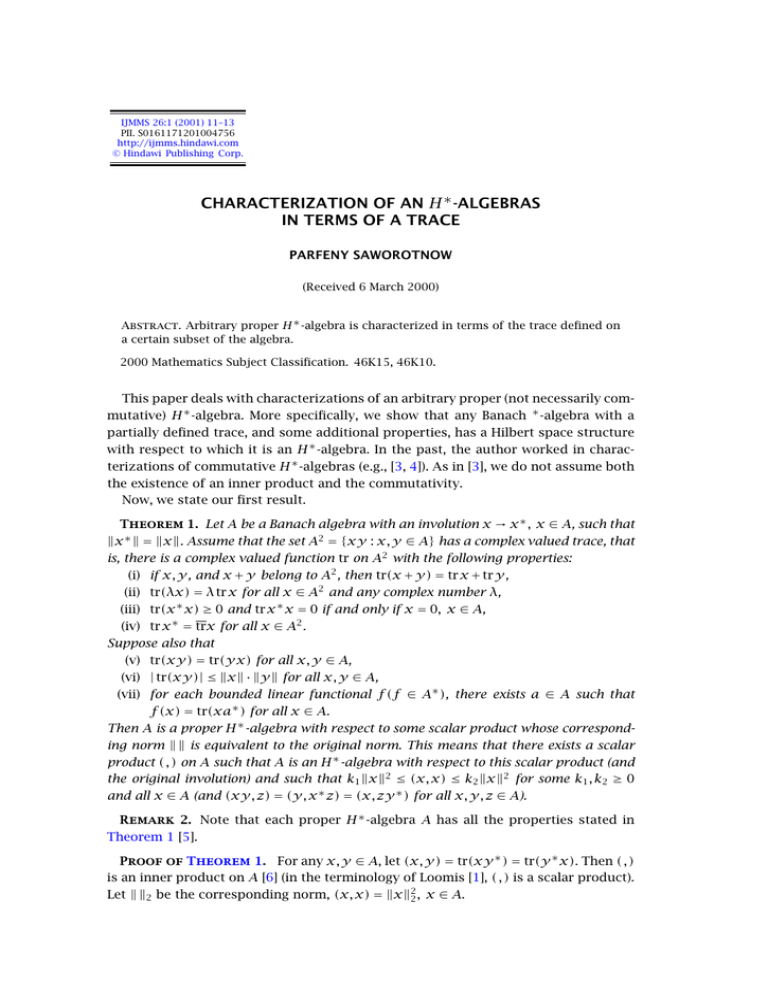
IJMMS 26:1 (2001) 11–13
PII. S0161171201004756
http://ijmms.hindawi.com
© Hindawi Publishing Corp.
CHARACTERIZATION OF AN H ∗ -ALGEBRAS
IN TERMS OF A TRACE
PARFENY SAWOROTNOW
(Received 6 March 2000)
Abstract. Arbitrary proper H ∗ -algebra is characterized in terms of the trace defined on
a certain subset of the algebra.
2000 Mathematics Subject Classification. 46K15, 46K10.
This paper deals with characterizations of an arbitrary proper (not necessarily commutative) H ∗ -algebra. More specifically, we show that any Banach ∗ -algebra with a
partially defined trace, and some additional properties, has a Hilbert space structure
with respect to which it is an H ∗ -algebra. In the past, the author worked in characterizations of commutative H ∗ -algebras (e.g., [3, 4]). As in [3], we do not assume both
the existence of an inner product and the commutativity.
Now, we state our first result.
Theorem 1. Let A be a Banach algebra with an involution x → x ∗ , x ∈ A, such that
x ∗ = x. Assume that the set A2 = {xy : x, y ∈ A} has a complex valued trace, that
is, there is a complex valued function tr on A2 with the following properties:
(i) if x, y, and x + y belong to A2 , then tr(x + y) = tr x + tr y,
(ii) tr(λx) = λ tr x for all x ∈ A2 and any complex number λ,
(iii) tr(x ∗ x) ≥ 0 and tr x ∗ x = 0 if and only if x = 0, x ∈ A,
(iv) tr x ∗ = trx for all x ∈ A2 .
Suppose also that
(v) tr(xy) = tr(yx) for all x, y ∈ A,
(vi) | tr(xy)| ≤ x · y for all x, y ∈ A,
(vii) for each bounded linear functional f (f ∈ A∗ ), there exists a ∈ A such that
f (x) = tr(xa∗ ) for all x ∈ A.
Then A is a proper H ∗ -algebra with respect to some scalar product whose corresponding norm is equivalent to the original norm. This means that there exists a scalar
product ( , ) on A such that A is an H ∗ -algebra with respect to this scalar product (and
the original involution) and such that k1 x2 ≤ (x, x) ≤ k2 x2 for some k1 , k2 ≥ 0
and all x ∈ A (and (xy, z) = (y, x ∗ z) = (x, zy ∗ ) for all x, y, z ∈ A).
Remark 2. Note that each proper H ∗ -algebra A has all the properties stated in
Theorem 1 [5].
Proof of Theorem 1. For any x, y ∈ A, let (x, y) = tr(xy ∗ ) = tr(y ∗ x). Then ( , )
is an inner product on A [6] (in the terminology of Loomis [1], ( , ) is a scalar product).
Let 2 be the corresponding norm, (x, x) = x22 , x ∈ A.
12
PARFENY SAWOROTNOW
We show that A is complete with respect to this new norm 2 . Let {an } be a Cauchy
sequence, limm,n an − am 2 = 0. Then there exists M > 0 such that an 2 ≤ M for all
n (every Cauchy sequence is bounded). For any fixed x ∈ A, the sequence {tr(xa∗
n )}
of complex numbers is also Cauchy
∗ tr xa − tr xa∗ ≤ x2 an − am .
n
n
2
(1)
So there is a complex number λx such that tr(xa∗
n ) → λx , n → ∞. Define the complex
valued function f on A by setting f (x) = λx . It follows from
an ≤ M,
2
f (x) = lim tr xa∗
n ,
(2)
and the linearity of tr that f is a bounded linear functional on A(f ∈ A∗ ). Assumption
(vii) in Theorem 1 implies that there exists a ∈ A such that
(x, a) = f (x) = lim tr xa∗
n.
(3)
n
We show that limn→∞ an − a2 = 0. Let > 0 be arbitrary, and let n0 be such that
an − am 2 < /2 for all n, m > n0 . Let n > n0 be fixed and arbitrary. The following
relation:
a − an 2 = a − an , a − am + a − an , am − an 2
= a − a n , a − a − a n , a m + a − a n , am − a n (4)
≤ f a − an − a − an , am + a − an · an − am 2
≤ f a − an − a − an , am + a − an 2
2
2
shows that a − an 22 ≤ a − an 2 , since we can always find m > n0 so that
|f (a − an ) − (a − an , am )| ≤ /2a − an 2 . Hence, a − an 2 ≤ for any n > n0 . This
proves that A is complete in this new norm 2 .
It follows from (vi) that x2 ≤ x ((x, x) ≤ x x ∗ = x2 for all x ∈ A). Closed
graph theorem [1] tells us that 2 is equivalent to the original norm.
Now, it is an easy exercise to show that A is an H ∗ -algebra with respect to the inner
product ( , ).
Now we state a slightly different characterization. It may not look like much of
improvement over Theorem 1, but it allows for a larger class of examples. In fact, if
we take any proper H ∗ -algebra A and replace its norm by any other norm equivalent to
the original one, we get a canonical example of a Banach algebra which both satisfies
the conditions of the following theorem and is characterized by it.
Theorem 3. Let A be a Banach algebra with continuous involution x → x ∗ , x ∈ A.
Assume that the set A2 = {xy : x, y ∈ A} has a trace tr with the following properties:
(i) if x, y, x + y ∈ A2 , then tr(x + y) = tr x + tr y,
(ii) tr(λx) = λ tr x for all x ∈ A2 and each complex number λ,
(iii) tr(x ∗ x) ≥ 0 and tr(x ∗ x) = 0 if and only if x = 0 (x ∈ A),
(iv) tr x ∗ = trx, x ∈ A2 ,
(v) tr(xy) = tr(yx) for all x, y ∈ A.
CHARACTERIZATION OF AN H ∗ -ALGEBRAS IN TERMS OF A TRACE
13
Assume further that
(vi) for each a ∈ A the map Ta : x → tr(xa∗ )(= Ta (x)) is continuous (Ta ∈ A∗
for each a ∈ A),
(vii) for each bounded linear functional f (f ∈ A∗ ) there exists a ∈ A such that
f (x) = tr(xa∗ ) for all x ∈ A.
Then A has a structure of a proper H ∗ -algebra with respect to some scalar product ( , )
such that kx2 ≤ (x, x) ≤ Kx2 for all x ∈ A and some k, K > 0.
Remark 4. Note that (vi) is equivalent to the following condition:
(vi) there exists M > 0 such that | tr(xy)| ≤ Mx · y for all x, y ∈ A.
It is a consequence of uniform boundness theorem [6, page 239]. Proof of this fact is
similar to the proof of Lemma 1 in [2]. Note also that continuity of involution implies
that there exists B > 0 such that x ∗ ≤ Bx, x ∈ A.
Proof of Theorem 3. We leave it to the reader to modify the proof of Theorem 1
in order to verify validity of Theorem 3.
References
[1]
[2]
[3]
[4]
[5]
[6]
L. H. Loomis, An Introduction to Abstract Harmonic Analysis, D. Van Nostrand Company,
New York, 1953. MR 14,883c. Zbl 052.11701.
P. P. Saworotnow, On continuity of multiplication in a complemented algebra, Pacific J.
Math. 14 (1964), 1399–1403. MR 30#2361. Zbl 154.15102.
, A simple characterization of commutative H ∗ -algebras, Int. J. Math. Math. Sci. 22
(1999), no. 4, 885–888. MR 2000i:46045. Zbl 991.48198.
, An exotic characterization of a commutative H ∗ -algebra, Int. J. Math. Math. Sci. 24
(2000), no. 1, 1–4. CMP 1 773 964. Zbl 991.64627.
P. P. Saworotnow and J. C. Friedell, Trace-class for an arbitrary H ∗ -algebra, Proc. Amer.
Math. Soc. 26 (1970), 95–100. MR 42#2304. Zbl 197.39701.
G. F. Simmons, Introduction to Topology and Modern Analysis, McGraw-Hill Book Co., New
York, 1963. MR 26#4145. Zbl 105.30603.
Parfeny Saworotnow: Department of Mathematics, Catholic University of America,
Washington, DC 20064, USA
E-mail address: saworotnow@cua.edu

